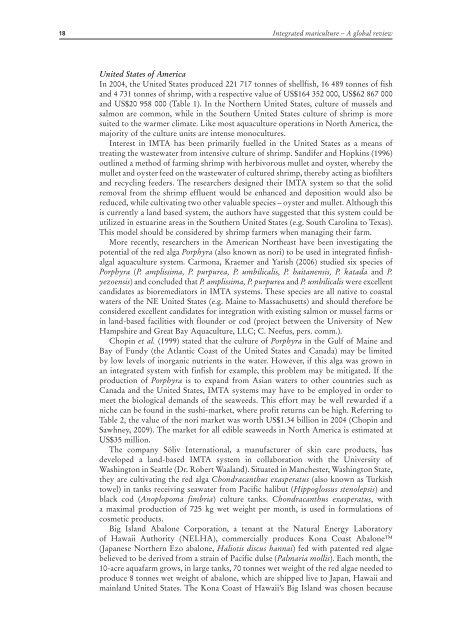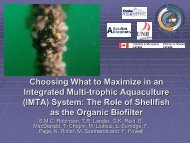Integrated multi-trophic aquaculture (IMTA) in marine temperate waters
Integrated multi-trophic aquaculture (IMTA) in marine temperate waters
Integrated multi-trophic aquaculture (IMTA) in marine temperate waters
Create successful ePaper yourself
Turn your PDF publications into a flip-book with our unique Google optimized e-Paper software.
18<br />
<strong>Integrated</strong> mariculture – A global review<br />
United States of America<br />
In 2004, the United States produced 221 717 tonnes of shellfish, 16 489 tonnes of fish<br />
and 4 731 tonnes of shrimp, with a respective value of US$164 352 000, US$62 867 000<br />
and US$20 958 000 (Table 1). In the Northern United States, culture of mussels and<br />
salmon are common, while <strong>in</strong> the Southern United States culture of shrimp is more<br />
suited to the warmer climate. Like most <strong>aquaculture</strong> operations <strong>in</strong> North America, the<br />
majority of the culture units are <strong>in</strong>tense monocultures.<br />
Interest <strong>in</strong> <strong>IMTA</strong> has been primarily fuelled <strong>in</strong> the United States as a means of<br />
treat<strong>in</strong>g the wastewater from <strong>in</strong>tensive culture of shrimp. Sandifer and Hopk<strong>in</strong>s (1996)<br />
outl<strong>in</strong>ed a method of farm<strong>in</strong>g shrimp with herbivorous mullet and oyster, whereby the<br />
mullet and oyster feed on the wastewater of cultured shrimp, thereby act<strong>in</strong>g as biofilters<br />
and recycl<strong>in</strong>g feeders. The researchers designed their <strong>IMTA</strong> system so that the solid<br />
removal from the shrimp effluent would be enhanced and deposition would also be<br />
reduced, while cultivat<strong>in</strong>g two other valuable species – oyster and mullet. Although this<br />
is currently a land based system, the authors have suggested that this system could be<br />
utilized <strong>in</strong> estuar<strong>in</strong>e areas <strong>in</strong> the Southern United States (e.g. South Carol<strong>in</strong>a to Texas).<br />
This model should be considered by shrimp farmers when manag<strong>in</strong>g their farm.<br />
More recently, researchers <strong>in</strong> the American Northeast have been <strong>in</strong>vestigat<strong>in</strong>g the<br />
potential of the red alga Porphyra (also known as nori) to be used <strong>in</strong> <strong>in</strong>tegrated f<strong>in</strong>fishalgal<br />
<strong>aquaculture</strong> system. Carmona, Kraemer and Yarish (2006) studied six species of<br />
Porphyra (P. amplissima, P. purpurea, P. umbilicalis, P. haitanensis, P. katada and P.<br />
yezoensis) and concluded that P. amplissima, P. purpurea and P. umbilicalis were excellent<br />
candidates as bioremediators <strong>in</strong> <strong>IMTA</strong> systems. These species are all native to coastal<br />
<strong>waters</strong> of the NE United States (e.g. Ma<strong>in</strong>e to Massachusetts) and should therefore be<br />
considered excellent candidates for <strong>in</strong>tegration with exist<strong>in</strong>g salmon or mussel farms or<br />
<strong>in</strong> land-based facilities with flounder or cod (project between the University of New<br />
Hampshire and Great Bay Aquaculture, LLC; C. Neefus, pers. comm.).<br />
Chop<strong>in</strong> et al. (1999) stated that the culture of Porphyra <strong>in</strong> the Gulf of Ma<strong>in</strong>e and<br />
Bay of Fundy (the Atlantic Coast of the United States and Canada) may be limited<br />
by low levels of <strong>in</strong>organic nutrients <strong>in</strong> the water. However, if this alga was grown <strong>in</strong><br />
an <strong>in</strong>tegrated system with f<strong>in</strong>fish for example, this problem may be mitigated. If the<br />
production of Porphyra is to expand from Asian <strong>waters</strong> to other countries such as<br />
Canada and the United States, <strong>IMTA</strong> systems may have to be employed <strong>in</strong> order to<br />
meet the biological demands of the seaweeds. This effort may be well rewarded if a<br />
niche can be found <strong>in</strong> the sushi-market, where profit returns can be high. Referr<strong>in</strong>g to<br />
Table 2, the value of the nori market was worth US$1.34 billion <strong>in</strong> 2004 (Chop<strong>in</strong> and<br />
Sawhney, 2009). The market for all edible seaweeds <strong>in</strong> North America is estimated at<br />
US$35 million.<br />
The company Söliv International, a manufacturer of sk<strong>in</strong> care products, has<br />
developed a land-based <strong>IMTA</strong> system <strong>in</strong> collaboration with the University of<br />
Wash<strong>in</strong>gton <strong>in</strong> Seattle (Dr. Robert Waaland). Situated <strong>in</strong> Manchester, Wash<strong>in</strong>gton State,<br />
they are cultivat<strong>in</strong>g the red alga Chondracanthus exasperatus (also known as Turkish<br />
towel) <strong>in</strong> tanks receiv<strong>in</strong>g seawater from Pacific halibut (Hippoglossus stenolepsis) and<br />
black cod (Anoplopoma fimbria) culture tanks. Chondracanthus exasperatus, with<br />
a maximal production of 725 kg wet weight per month, is used <strong>in</strong> formulations of<br />
cosmetic products.<br />
Big Island Abalone Corporation, a tenant at the Natural Energy Laboratory<br />
of Hawaii Authority (NELHA), commercially produces Kona Coast Abalone<br />
(Japanese Northern Ezo abalone, Haliotis discus hannai) fed with patented red algae<br />
believed to be derived from a stra<strong>in</strong> of Pacific dulse (Palmaria mollis). Each month, the<br />
10-acre aquafarm grows, <strong>in</strong> large tanks, 70 tonnes wet weight of the red algae needed to<br />
produce 8 tonnes wet weight of abalone, which are shipped live to Japan, Hawaii and<br />
ma<strong>in</strong>land United States. The Kona Coast of Hawaii’s Big Island was chosen because



